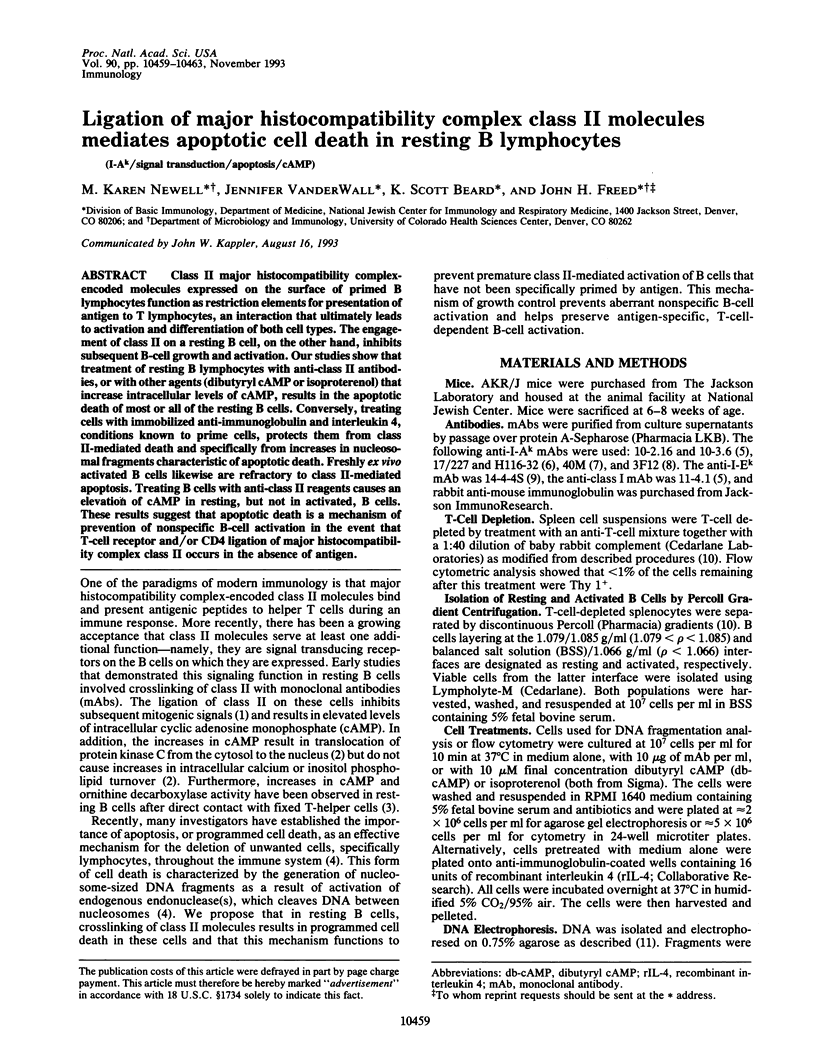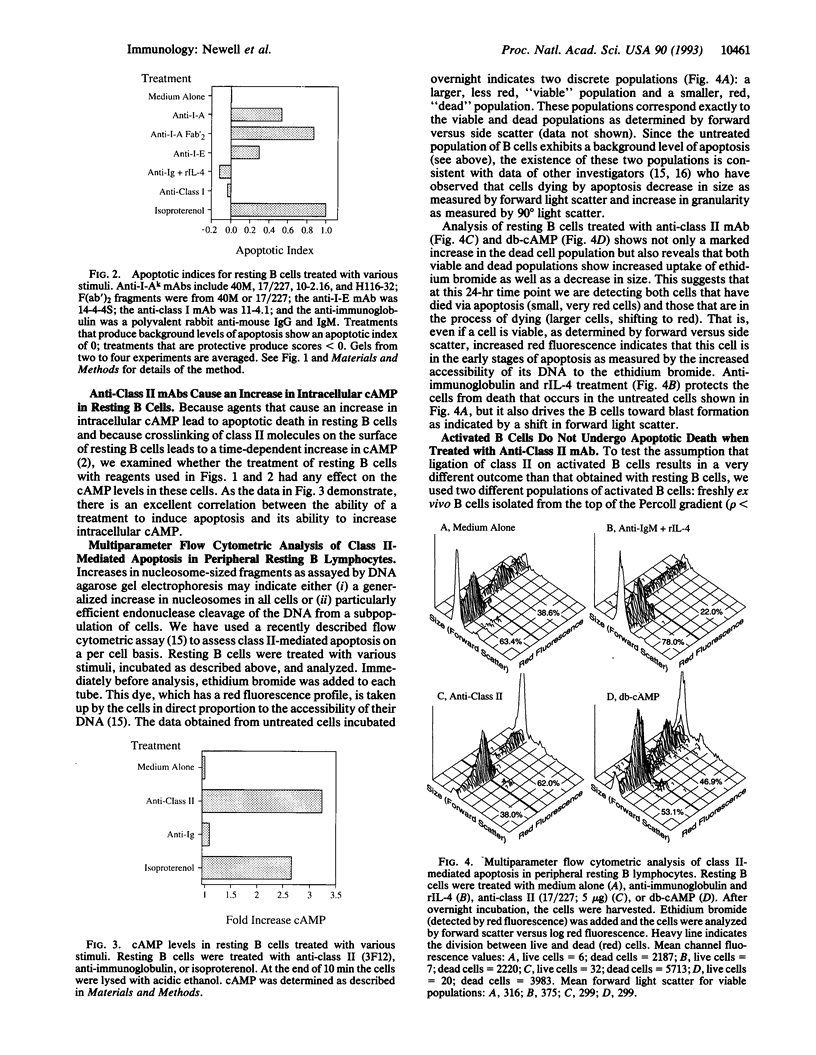Abstract
Class II major histocompatibility complex-encoded molecules expressed on the surface of primed B lymphocytes function as restriction elements for presentation of antigen to T lymphocytes, an interaction that ultimately leads to activation and differentiation of both cell types. The engagement of class II on a resting B cell, on the other hand, inhibits subsequent B-cell growth and activation. Our studies show that treatment of resting B lymphocytes with anti-class II antibodies, or with other agents (dibutyryl cAMP or isoproterenol) that increase intracellular levels of cAMP, results in the apoptotic death of most or all of the resting B cells. Conversely, treating cells with immobilized anti-immunoglobulin and interleukin 4, conditions known to prime cells, protects them from class II-mediated death and specifically from increases in nucleosomal fragments characteristic of apoptotic death. Freshly ex vivo activated B cells likewise are refractory to class II-mediated apoptosis. Treating B cells with anti-class II reagents causes an elevation of cAMP in resting, but not in activated, B cells. These results suggest that apoptotic death is a mechanism of prevention of nonspecific B-cell activation in the event that T-cell receptor and/or CD4 ligation of major histocompatibility complex class II occurs in the absence of antigen.
Full text
PDF




Images in this article
Selected References
These references are in PubMed. This may not be the complete list of references from this article.
- Beck B. N., Buerstedde J. M., Krco C. J., Nilson A. E., Chase C. G., McKean D. J. Characterization of cell lines expressing mutant I-Ab and I-Ak molecules allows the definition of distinct serologic epitopes on A alpha and A beta polypeptides. J Immunol. 1986 Apr 15;136(8):2953–2961. [PubMed] [Google Scholar]
- Bissonnette R. P., Echeverri F., Mahboubi A., Green D. R. Apoptotic cell death induced by c-myc is inhibited by bcl-2. Nature. 1992 Oct 8;359(6395):552–554. doi: 10.1038/359552a0. [DOI] [PubMed] [Google Scholar]
- Cambier J. C., Lehmann K. R. Ia-mediated signal transduction leads to proliferation of primed B lymphocytes. J Exp Med. 1989 Sep 1;170(3):877–886. doi: 10.1084/jem.170.3.877. [DOI] [PMC free article] [PubMed] [Google Scholar]
- Cambier J. C., Morrison D. C., Chien M. M., Lehmann K. R. Modeling of T cell contact-dependent B cell activation. IL-4 and antigen receptor ligation primes quiescent B cells to mobilize calcium in response to Ia cross-linking. J Immunol. 1991 Apr 1;146(7):2075–2082. [PubMed] [Google Scholar]
- Cambier J. C., Newell M. K., Justement L. B., McGuire J. C., Leach K. L., Chen Z. Z. Ia binding ligands and cAMP stimulate nuclear translocation of PKC in B lymphocytes. Nature. 1987 Jun 18;327(6123):629–632. doi: 10.1038/327629a0. [DOI] [PubMed] [Google Scholar]
- Cohen J. J., Duke R. C., Fadok V. A., Sellins K. S. Apoptosis and programmed cell death in immunity. Annu Rev Immunol. 1992;10:267–293. doi: 10.1146/annurev.iy.10.040192.001411. [DOI] [PubMed] [Google Scholar]
- Duke R. C., Chervenak R., Cohen J. J. Endogenous endonuclease-induced DNA fragmentation: an early event in cell-mediated cytolysis. Proc Natl Acad Sci U S A. 1983 Oct;80(20):6361–6365. doi: 10.1073/pnas.80.20.6361. [DOI] [PMC free article] [PubMed] [Google Scholar]
- Eynon E. E., Parker D. C. Small B cells as antigen-presenting cells in the induction of tolerance to soluble protein antigens. J Exp Med. 1992 Jan 1;175(1):131–138. doi: 10.1084/jem.175.1.131. [DOI] [PMC free article] [PubMed] [Google Scholar]
- Forsgren S., Pobor G., Coutinho A., Pierres M. The role of I-A/E molecules in B lymphocyte activation. I. Inhibition of lipopolysaccharide-induced responses by monoclonal antibodies. J Immunol. 1984 Oct;133(4):2104–2110. [PubMed] [Google Scholar]
- Fuchs E. J., Matzinger P. B cells turn off virgin but not memory T cells. Science. 1992 Nov 13;258(5085):1156–1159. doi: 10.1126/science.1439825. [DOI] [PubMed] [Google Scholar]
- Jenkinson E. J., Kingston R., Smith C. A., Williams G. T., Owen J. J. Antigen-induced apoptosis in developing T cells: a mechanism for negative selection of the T cell receptor repertoire. Eur J Immunol. 1989 Nov;19(11):2175–2177. doi: 10.1002/eji.1830191132. [DOI] [PubMed] [Google Scholar]
- Julius M., Haughn L. The induction of resting B cell differentiation does not require T cell contact. Eur J Immunol. 1992 Sep;22(9):2323–2329. doi: 10.1002/eji.1830220922. [DOI] [PubMed] [Google Scholar]
- Kammer G. M., Boehm C. A., Rudolph S. A., Schultz L. A. Mobility of the human T lymphocyte surface molecules CD3, CD4, and CD8: regulation by a cAMP-dependent pathway. Proc Natl Acad Sci U S A. 1988 Feb;85(3):792–796. doi: 10.1073/pnas.85.3.792. [DOI] [PMC free article] [PubMed] [Google Scholar]
- Lanotte M., Riviere J. B., Hermouet S., Houge G., Vintermyr O. K., Gjertsen B. T., Døskeland S. O. Programmed cell death (apoptosis) is induced rapidly and with positive cooperativity by activation of cyclic adenosine monophosphate-kinase I in a myeloid leukemia cell line. J Cell Physiol. 1991 Jan;146(1):73–80. doi: 10.1002/jcp.1041460110. [DOI] [PubMed] [Google Scholar]
- McConkey D. J., Orrenius S., Jondal M. Agents that elevate cAMP stimulate DNA fragmentation in thymocytes. J Immunol. 1990 Aug 15;145(4):1227–1230. [PubMed] [Google Scholar]
- Nabavi N., Freeman G. J., Gault A., Godfrey D., Nadler L. M., Glimcher L. H. Signalling through the MHC class II cytoplasmic domain is required for antigen presentation and induces B7 expression. Nature. 1992 Nov 19;360(6401):266–268. doi: 10.1038/360266a0. [DOI] [PubMed] [Google Scholar]
- Newell M. K., Haughn L. J., Maroun C. R., Julius M. H. Death of mature T cells by separate ligation of CD4 and the T-cell receptor for antigen. Nature. 1990 Sep 20;347(6290):286–289. doi: 10.1038/347286a0. [DOI] [PubMed] [Google Scholar]
- Nitta T., Suzuki T. Biochemical signals transmitted by Fc gamma receptors: triggering mechanisms of the increased synthesis of adenosine-3',5'-cyclic monophosphate mediated by Fc gamma 2a- and Fc gamma 2b- -receptors of a murine macrophage-like cell line (P388D1). J Immunol. 1982 Dec;129(6):2708–2714. [PubMed] [Google Scholar]
- Oi V. T., Jones P. P., Goding J. W., Herzenberg L. A., Herzenberg L. A. Properties of monoclonal antibodies to mouse Ig allotypes, H-2, and Ia antigens. Curr Top Microbiol Immunol. 1978;81:115–120. doi: 10.1007/978-3-642-67448-8_18. [DOI] [PubMed] [Google Scholar]
- Ozato K., Mayer N., Sachs D. H. Hybridoma cell lines secreting monoclonal antibodies to mouse H-2 and Ia antigens. J Immunol. 1980 Feb;124(2):533–540. [PubMed] [Google Scholar]
- Pierres M., Devaux C., Dosseto M., Marchetto S. Clonal analysis of B- and T-cell responses to Ia antigens. I. Topology of epitope regions on I-Ak and I-Ek molecules analyzed with 35 monoclonal alloantibodies. Immunogenetics. 1981 Dec;14(6):481–495. doi: 10.1007/BF00350120. [DOI] [PubMed] [Google Scholar]
- Pollok K. E., O'Brien V., Marshall L., Olson J. W., Noelle R. J., Snow E. C. The development of competence in resting B cells. The induction of cyclic AMP and ornithine decarboxylase activity after direct contact between B and T helper cells. J Immunol. 1991 Mar 1;146(5):1633–1641. [PubMed] [Google Scholar]
- Sellins K. S., Cohen J. J. Gene induction by gamma-irradiation leads to DNA fragmentation in lymphocytes. J Immunol. 1987 Nov 15;139(10):3199–3206. [PubMed] [Google Scholar]
- Shi Y. F., Sahai B. M., Green D. R. Cyclosporin A inhibits activation-induced cell death in T-cell hybridomas and thymocytes. Nature. 1989 Jun 22;339(6226):625–626. doi: 10.1038/339625a0. [DOI] [PubMed] [Google Scholar]
- St Pierre Y., Watts T. H. Characterization of the signaling function of MHC class II molecules during antigen presentation by B cells. J Immunol. 1991 Nov 1;147(9):2875–2882. [PubMed] [Google Scholar]
- Swat W., Ignatowicz L., Kisielow P. Detection of apoptosis of immature CD4+8+ thymocytes by flow cytometry. J Immunol Methods. 1991 Mar 1;137(1):79–87. doi: 10.1016/0022-1759(91)90396-w. [DOI] [PubMed] [Google Scholar]



